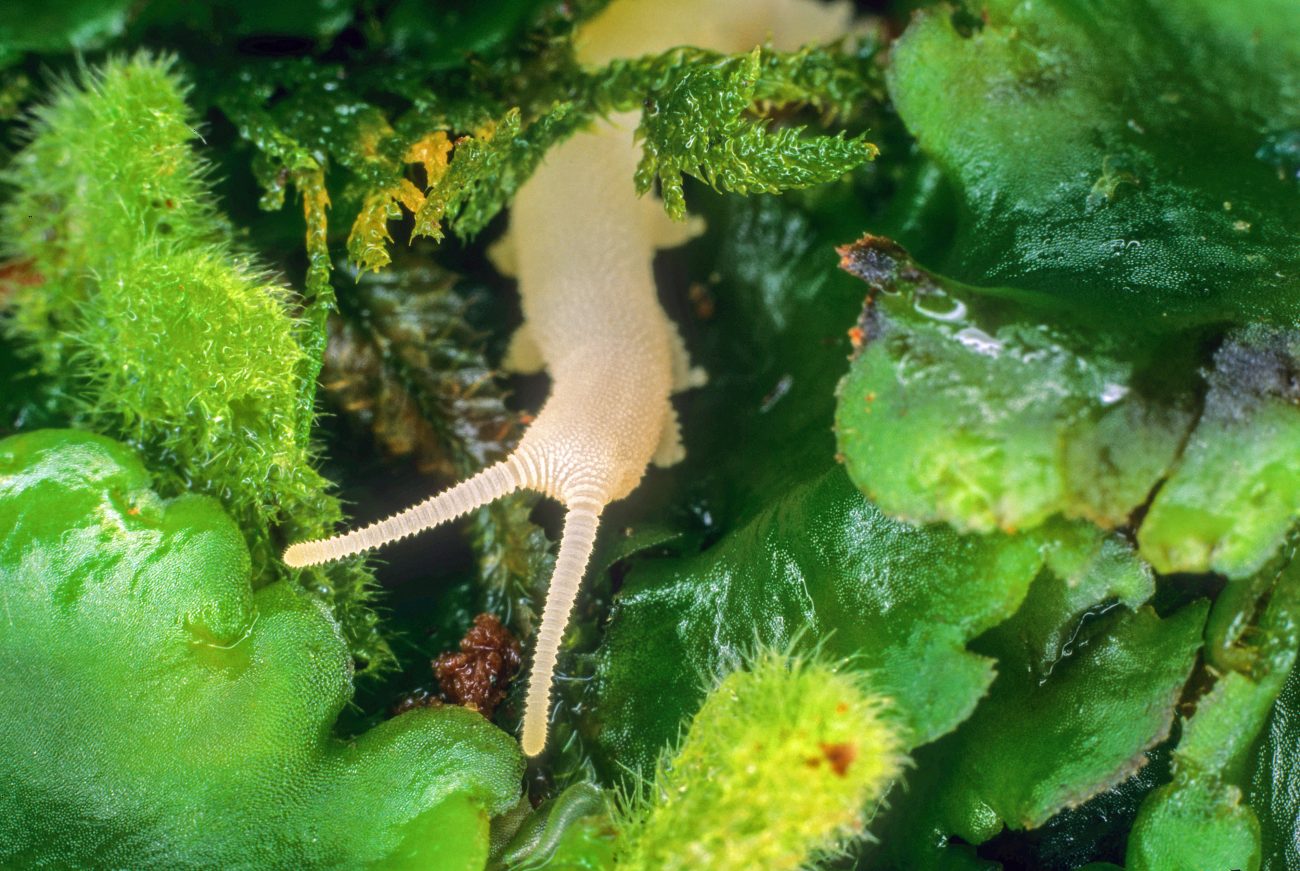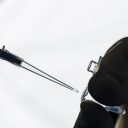
For the love of velvet worms
This creature is so old it defies imagination. Its genome is far more complex than ours—big enough to crash one of the country’s most powerful supercomputers. Will we lose the species before we glimpse the ancient stories it has to tell?
One late winter afternoon last year, geneticist Peter Dearden went looking for Gondwana in his garden.
Digging around in the bark of a tree fuchsia, he soon found exactly what he was looking for—a velvet-skinned, grey-blue, caterpillar-like creature, about five centimetres long, with 15 short stumpy legs, claws on its ‘feet’ and two antennae on its head.
It was one of the mysterious tribe Onychophora, commonly known as a peripatus, or in te reo, ngāokeoke—an ancient invertebrate that hunts smaller invertebrates by spitting a sticky glue at them, dissolving them with saliva, then drawing them into its circular, grinding maw.
Peripatus are a creature reminiscent of the sandworms from Frank Herbert’s science fiction classic Dune. But despite their other common name, velvet worm, this is not a worm. Nor is it a slug, a caterpillar, or a millipede. It’s something completely different. Something so old it seems almost alien.
Dearden put the unusual creature in a plastic container and took it to his laboratory at the University of Otago, in Dunedin. From the animal’s body, he extracted a small sample of DNA. Contained within was a story more than 500 million years long. Reading it was going to take some time.
[Chapter Break]
In the Canadian Rockies there’s a famous band of rock called the Burgess Shale. It holds the fossils of some of the oldest animals that ever existed. It’s a snapshot, in exquisite detail, of life on a patch of seafloor 550 million years ago. Among the beautifully preserved fossils are the outlines of animals that look very much like Onychophora.
Today, peripatus are terrestrial creatures found all around the southern hemisphere and also in parts of Central America, the Caribbean and Asia. They are considered direct descendants of those very early marine predators. New Zealand has nine known species, distributed around the country, but it is likely there are many times that number still undescribed.
When Dearden was a PhD student at Victoria University in the early 1990s, it astonished him that he could find these animals living in rotten logs and forest litter in the hills around Wellington. “Realising that was a huge first jolt,” he says. “From little old New Zealand we could really start to understand something about the evolution of life on Earth.”

These days, Dearden is the Dunedin-based director of Genomics Aotearoa, a group that specialises in sequencing genomes. Technology has finally caught up with his curiosity, allowing him to peer into the DNA of peripatus.
Dearden and his colleagues are attempting to sequence the genome of the peripatus he collected in his garden, to see what secrets about the evolution of life it can reveal. Doing so will offer insights into the evolution of their closest relatives, arthropods (the vast group of animals that includes insects, crustaceans, spiders and centipedes). It could also help us understand why peripatus have remained unchanged for such an enormous amount of time.
[sidebar-1]
Peripatus have been terrorising the undergrowth for just about as long as there has been anything you could describe as “undergrowth” on land. They were probably there when the first land vertebrates—our ancestors—crawled out of the sea and began laying eggs in swamps. They lived in the fallen logs of the world’s first forests, and survived the enormous extinctions that destroyed them. They saw the rise and demise of the dinosaurs, and the breakup of Gondwana.
It seems almost absurd that their epic journey should have brought them, of all places, to Dunedin’s Caversham Valley, where in 1988, Dave Randle found them living in a pile of bricks.
[Chapter Break]
It takes me a while to find Randle’s house, hidden as it is down the end of a long driveway that plunges through a scraggly woodland of weedy
exotic trees.
Eventually, I find myself on the doorstep of an old wooden Victorian-era house that’s swamped in urban overgrowth.
From the hillside above comes the rumble of bulldozers, the breaking of wet wood, the scream of a chainsaw. Up there, developers are hard at work, making way for new houses.
Randle moved here in 1982. At the time, this was a quiet hill suburb. Now, Dunedin’s southern motorway roars straight up the valley, right alongside his section.
One day, while moving a pile of bricks, he was astonished to find them full of peripatus—hundreds of them. Randle soon discovered there were peripatus everywhere on his property. As if guided by destiny, he had inadvertently found himself living in New Zealand’s, and perhaps the world’s, urban peripatus capital.
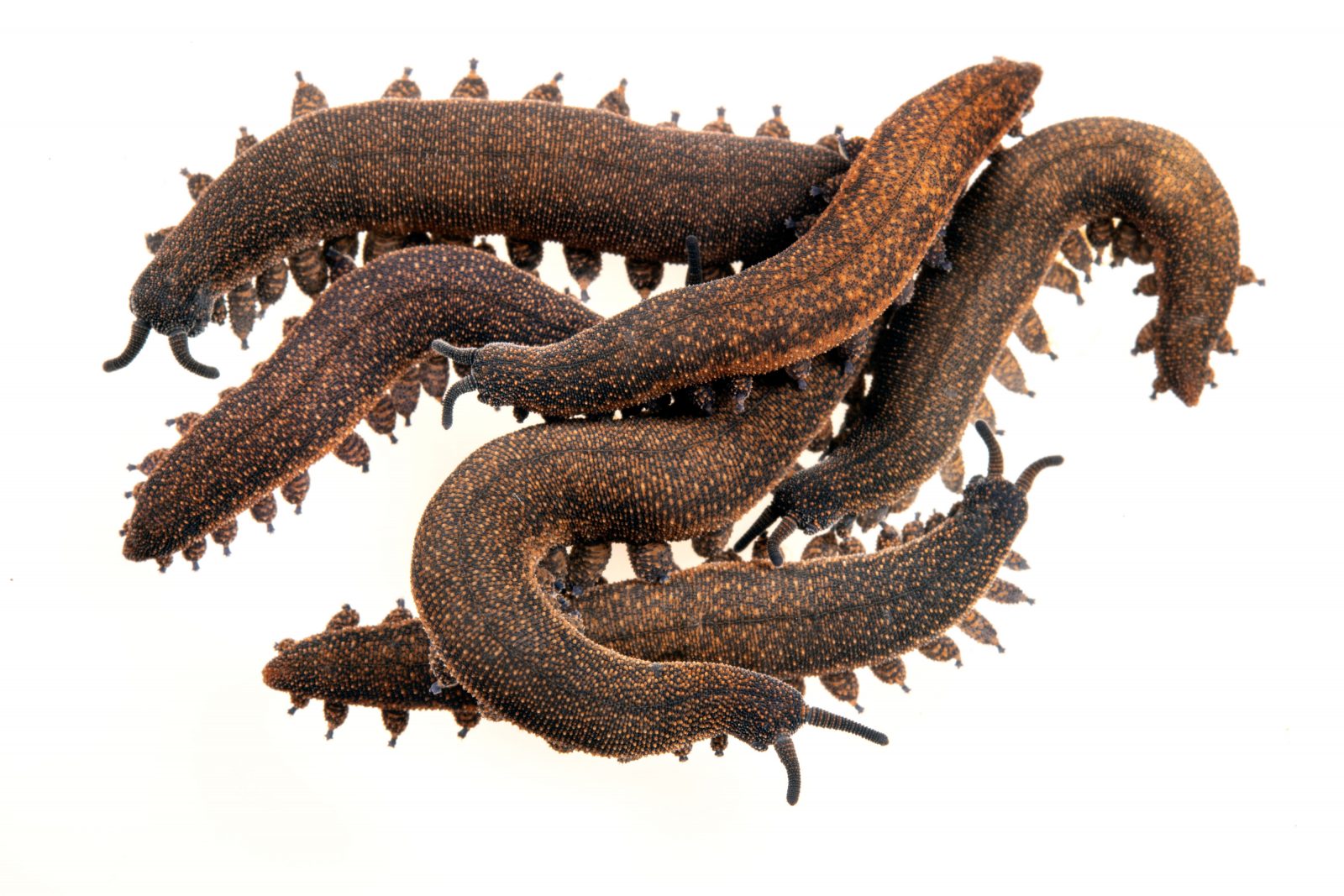
It is quite likely there are more peripatus living right here beside the motorway than at any other known site in the world. They are not living in pristine native forest, but in an unloved tangle of exotic trees, vines, scrub and weeds and in discarded plastic (prime habitat, apparently) and piles of rubble, right in the middle of a city.
Not only that, they seem to behave unlike peripatus elsewhere. Whereas ngāokeoke in New Zealand tend to be solitary animals—lone hunters of the forest floor—here, they cluster in huge breeding aggregations.
It’s almost certain, says Dianne Gleeson, a Canberra-based geneticist who, in her former role with Manaaki Whenua/Landcare Research, studied New Zealand’s Onychophora species extensively, that the peripatus on Dave Randle’s section are an undescribed species—one perhaps found only in Dunedin (although research suggests they may also be found in the surrounding hills of Otago.) That these charismatic animals don’t even have a scientific name, says Gleeson, speaks volumes about the information vacuum around peripatus.
Officially, no Onychophora species in New Zealand is considered threatened. But at the same time, almost no one is studying them to find out if any might be. Meanwhile, ongoing habitat destruction could already be taking a toll.
“There’s no one out there doing any sort of surveillance,” says Gleeson. She fears we will make some species extinct before we’ve even named them.
In 1996, spurred by the threat of subdivision in the valley, Randle and others fought hard and finally persuaded the Dunedin City Council to create a small peripatus reserve—most likely the first in the world.
Then, in 2010, Waka Kotahi, or the New Zealand Transport Agency, as it was known back then, announced plans to widen the motorway. The proposed expansion was to claim the bottom of Randle’s section—an area he knew was riddled with peripatus.
Again, Randle and others lobbied the council and government. Remarkably, their efforts temporarily halted the project. A land swap, exchanging highway space for peripatus habitat elsewhere in the valley, was agreed upon, and Randle provided the management plan, which involved shifting peripatus into those safe areas.
It was a milestone in New Zealand conservation—the first time a major roading infrastructure project had been halted in deference to the invertebrates that lived there.
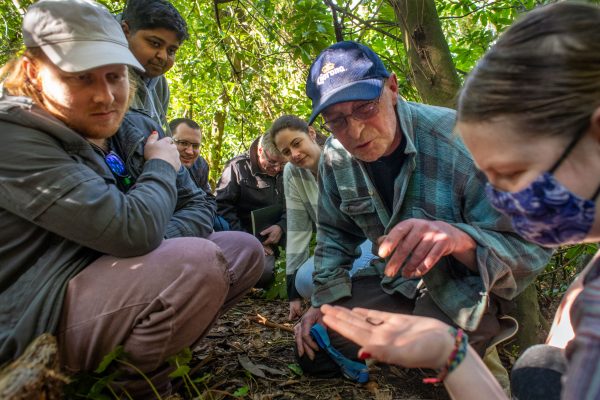
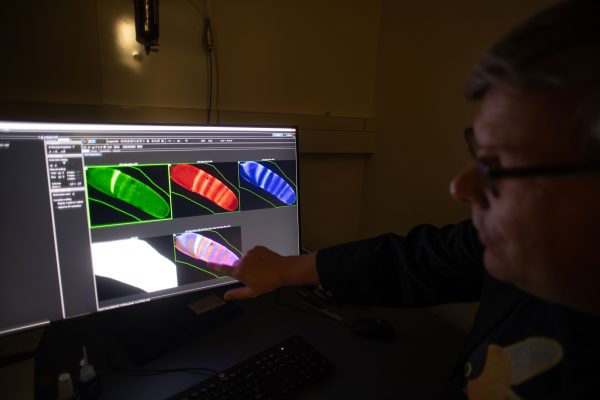
Randle’s efforts raised the profile of peripatus in Dunedin enormously. Inspired by his battle, others in the community embraced its secretive slime assassins. A craft beer brewery—Velvet Worm—was named in their honour. A large peripatus mural appeared on a wall in the Caversham Village.
Much-loved Dunedin musician and educator Tahu Mackenzie donned a peripatus suit to perform with her band, the Takahes, and an initiative called Peripatus Schools, led by the University of Otago and the Otago Museum, encouraged schoolchildren to find peripatus and learn more about urban biodiversity. Dunedin became the world’s most peripatus-aware city.
All of that started with Randle’s pile of bricks, and his unyielding conviction that someone needed to speak up for these animals.
“It’s kind of like it was meant to be that he bought that place,” says Gleeson, “because he’s just so passionate. We need people like that, who are passionate about the flora and fauna in their backyard and are prepared to fight.”
But time passes, and Dunedin has continued to grow. Caversham Valley is one of the last bits of undeveloped land in the city, and Randle’s hill section is now besieged on all sides. It’s this, more than the roar of diesels on the southbound, that keeps him awake at night.
[Chapter Break]
Peter Dearden and a group from his laboratory join me at Randle’s place to witness firsthand the extraordinary natural phenomenon of the valley’s peripatus swarm.
Randle leads us into a woodland dominated by pines, gum trees and sycamores. He has provided homes for peripatus here, in the forms of planks of old wood. He lifts one up and as the spiders, hoppers and slaters vacate the scene, I’m astonished to see dozens of peripatus enmeshed in the matrix of dirt, fungus and plant roots.
Randle pulls some out for us to look at. They elongate and morph in our hands, like horror-movie shapeshifters. Randle is mid-sentence when the crash of another tree being felled reverberates around the valley. His head drops and I see his whole body go tense, as if he’s been shot. “That’s peripatus dying,” he says.
As the incessant grind of the motorway once more drowns out the bulldozers, we get back to examining the peripatus at our feet. Dearden tells me he always experiences a kind of primal shock when seeing them in the wild like this. “It’s as if somebody turned over a log and there was a dinosaur. But actually, they’re much, much older than that.”
The sheer profusion of Onychophora in the Caversham Valley, says Dearden, defies understanding. “They’re predators, right? Imagine going to Africa and discovering it was just lions for miles. It doesn’t make a lot of sense.
“There’s something very special about [this] place that we don’t understand.”
[Chapter Break]
A few days later, I’m in the Genomics Aotearoa lab at the University of Otago, where I get a look at what Dearden calls their “sequency-thing”. It looks like a small flash drive, something you’d save your holiday snaps on.
Actually, it’s a cutting-edge Oxford Nanopore genome sequencer. Inside, a black membrane is punctured by nano-sized holes. “We load the DNA onto this array,” says Dearden. “There’s an enzyme which then grabs the DNA and pushes it through the holes.”

DNA is made up of four bases—A,C,T and G—which join to one another to form ‘base pairs’. With these four letters, nature writes the extraordinarily complex body of code that builds an organism, controls its behaviour and allows it to reproduce—its genome.
As the strands of DNA are pushed through the holes on the reader, the various base pairs interrupt an electrical field in slightly different ways. “What you get is a kind of map of the changes,” says Dearden. “We take that information and turn it into a DNA sequence.”
This isn’t the first time someone’s tried to sequence the peripatus genome. An American group tried and failed—in the main because the peripatus genome is really, really big, approximately 12 billion base pairs. For comparison, the human genome contains only three billion base pairs.
The lab’s high-powered computer is churning away on a DNA sequence when we log in. After working all through the night, the machine has read 1.2 billion base pairs. Reading DNA is not an exact science—getting an accurate read requires every part of the genome to be read at least 10 times. I do the maths in my head—at this rate, reading the 12 billion base pairs of the peripatus genome will require 100 nights of heavy processing.
And that, explains Dearden, is just what’s needed to generate the raw data. In order to turn that into usable information, the data is sent, via fibre-optic cable, to the New Zealand eScience Infrastructure (NeSI) supercomputer in Wellington, which goes to work building the genome.
Dearden proudly tells me they’ve crashed the NeSI computer several times. In the world of genome sequencing, he says, “this is on the edge of possible”. If they are successful, the team will have the first complete blueprint for what makes an Onychophora. For Dearden, this is a personal quest to better understand the spectacular, barely understood creature he shares his city with.
“Something we keep finding in New Zealand biology is how little we know,” he says. In terms of peripatus, “there are a couple of papers, one of which describes a pile of bricks up at Dave’s place where they found a load of peripatus. It’s really at that kind of level.
“That really worries me, because peripatus is pretty big. What do we know about the little snails that live everywhere? What do we know about the springtails? Or the centipedes and millipedes?”
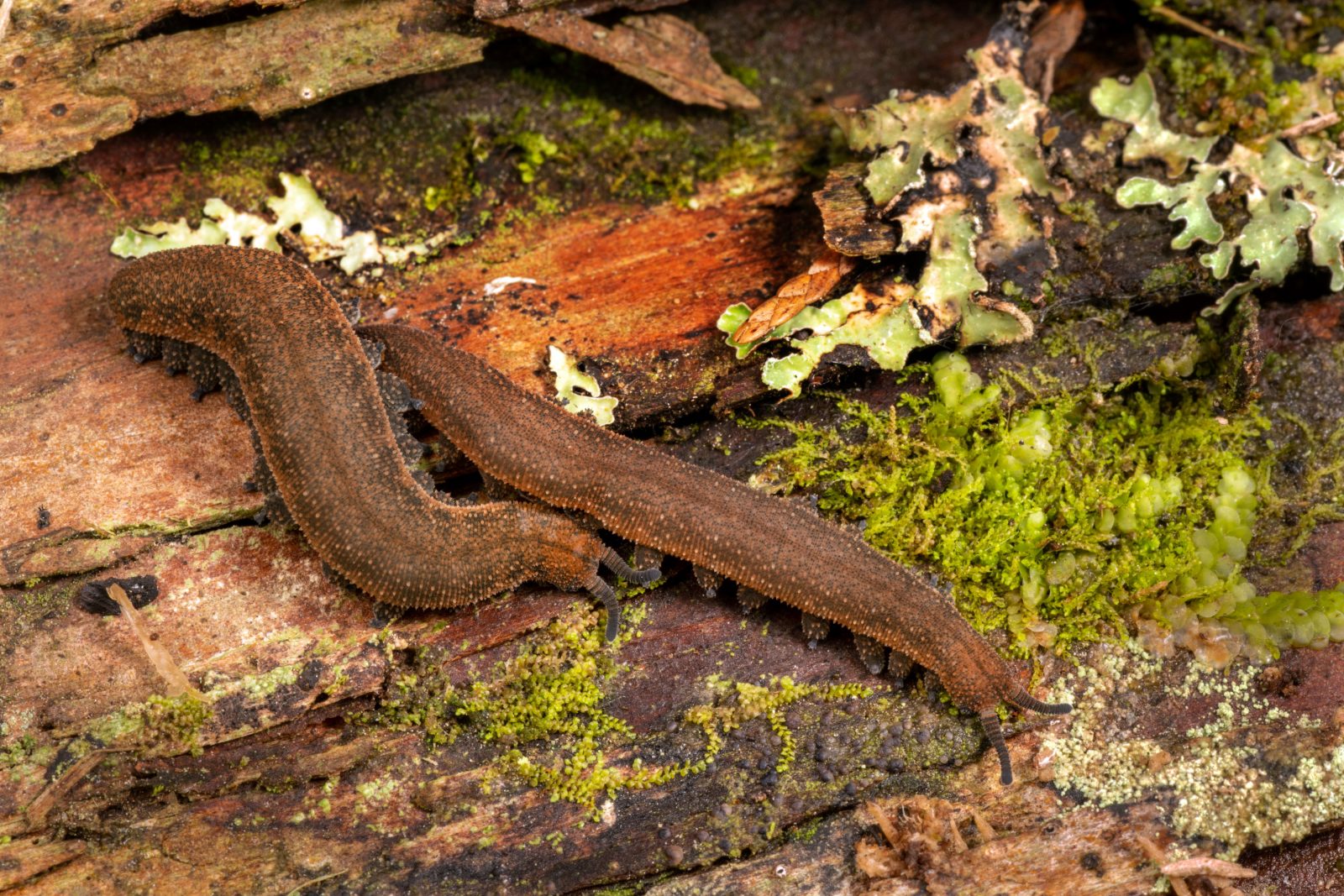
Edward Ellison, of Te Rūnanga o Ōtākou, shares Dearden’s concerns. As mana whenua, the Otago rūnanga granted Dearden and his team permission to sequence the Dunedin peripatus genome– access Ellison says is not given lightly.
“There’s got to be a good kaitiaki reason why they’re doing it,” he explains, “and that it’s for the purpose of benefiting the population, not just a mining exercise.”
Peripatus, he says, are “part of the chain”, an important component of a healthy ecosystem.
“It’s one of those indicators. If we’re to maintain some balance, we’ve got to look after these unseen things.”
The idea that we might lose a peripatus species, either in Dunedin or elsewhere, before we’ve even had a chance to name them has galvanised Dearden to trial keeping some in captivity.
From Randle’s place, he has collected around 100 peripatus, and is now keeping them alive in a fridge in his lab. “As geneticists,” he says, “we want to study them. But we also don’t want to lose them. So, can we set up captive colonies? Then at least there is a bit of a backup.
“It’s not ideal. We’d rather maintain the environment, but that seems to be difficult.”
[Chapter Break]
Up in the Caversham Valley, Randle fights a lonely battle. In the many conversations I have with him, his disappointment with local authorities and the Department of Conservation is palpable. The peripatus reserve set aside by the city council, he says, is no longer a good habitat for the creatures. Well-meaning staff removed all the exotic trees and planted natives, but these will take many more years to be big enough to create the tangle of fallen wood debris and leaf litter that peripatus require.
Soon, he fears, his small block will be the last oasis for peripatus in the valley. But despite his disillusionment, Randle’s efforts in the Caversham Valley have set an important precedent. Today, no highway expansion or other major infrastructure development in New Zealand is able to proceed without taking into account peripatus, and by extension, the countless skinks, geckos and invertebrates of the forest floor that may also be affected.
Roger MacGibbon worked alongside Randle to implement the management plan in the Caversham Valley in 2012-13. Now, as principal ecologist with environmental consultancy firm Tonkin + Taylor, he leads the mitigation team involved in the Mount Messenger Highway bypass project in Taranaki.

There, a $280 million highway rerouting will destroy 30 hectares of native bush. MacGibbon’s job is to minimise the damage to native wildlife in the highway footprint.
To try to save peripatus, he’s using methods developed with Randle in the Caversham Valley. “The practice we tested,” he says, “was to pick up the large pieces of wood, particularly stumps, and just reposition them to a safe location. And that seems to work.
“We’re not going to destroy habitat to find [peripatus],” he says. “We’ll assume they’re there, pick that material up and move it to a safe position.
“Hopefully, if they’re present, they’ll carry on with their lives.”
After 550 million years on this planet, that would seem the least we could do.






